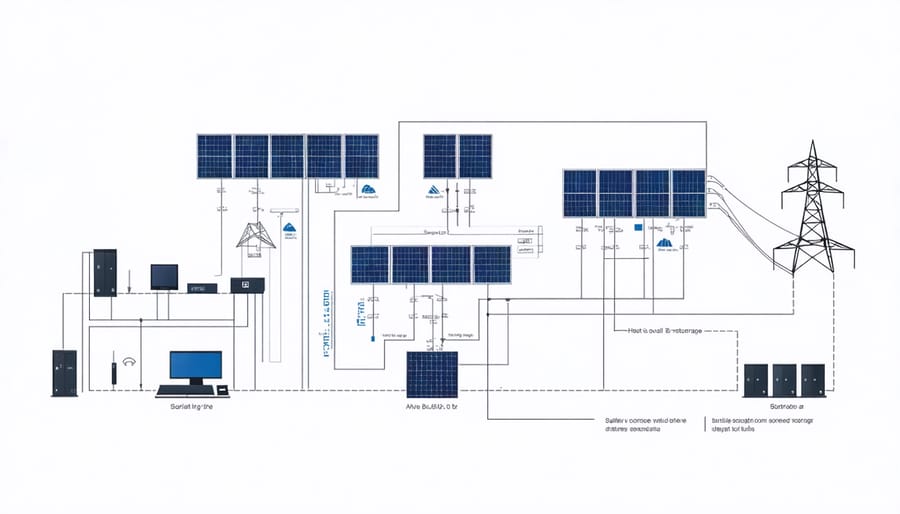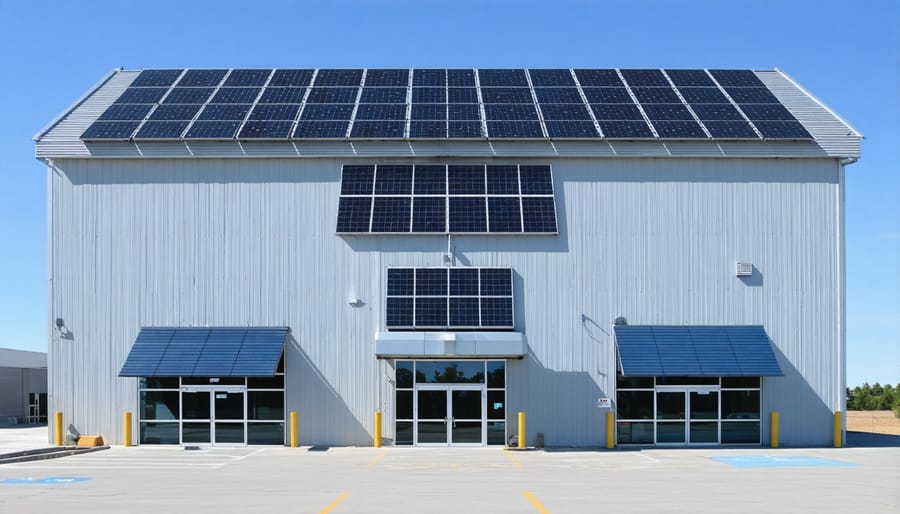V-grid energy systems represent a transformative approach to commercial building power management, integrating advanced microgrid technology with vertical distribution networks to maximize energy efficiency and resilience. These sophisticated systems enable buildings to operate independently or in conjunction with the main power grid, creating unprecedented flexibility in power distribution and consumption patterns.
By strategically combining renewable energy sources, energy storage solutions, and intelligent load management across multiple floors, v-grid systems optimize power flow throughout vertical structures while maintaining critical operations during grid disruptions. This architectural innovation has emerged as a crucial solution for modern urban developments, particularly in high-rise buildings where traditional power distribution faces significant challenges.
Recent implementations in commercial buildings have demonstrated energy cost reductions of 25-40%, while simultaneously enhancing grid stability and reducing carbon emissions. For construction professionals and building managers, understanding v-grid technology has become essential as the industry shifts toward more sustainable and resilient building practices.
As we examine the technical specifications, implementation strategies, and real-world applications of v-grid systems, this comprehensive analysis will provide valuable insights for industry professionals seeking to integrate these advanced energy solutions into their projects.
Understanding V-Grid Architecture
Core Components
V-grid energy systems rely on several interconnected components that work in harmony to deliver efficient and reliable power distribution. At the heart of these systems is the bidirectional power converter, which enables seamless energy flow between various sources and the grid. This component integrates with smart grid technology to optimize power distribution based on real-time demand and availability.
The energy storage system, typically comprising advanced lithium-ion batteries or similar high-capacity storage solutions, serves as the backbone of v-grid implementations. These storage units maintain power quality and ensure uninterrupted supply during peak demand or grid instability.
Advanced metering infrastructure (AMI) provides precise monitoring and data collection capabilities, while the energy management system (EMS) processes this information to make intelligent decisions about power distribution. The control system interface coordinates all components through sophisticated algorithms that balance load requirements, storage capacity, and grid conditions.
Protection devices and circuit breakers safeguard the system against electrical faults and overloads, while power quality monitors ensure that voltage and frequency remain within acceptable parameters. The distribution panel, equipped with smart switches and automated transfer capabilities, facilitates proper power routing throughout the facility.
System integration modules enable communication between components and external networks, ensuring that the v-grid system responds effectively to both local demands and grid-level requirements while maintaining optimal efficiency and reliability.

Integration Framework
V-grid energy systems seamlessly integrate with existing building infrastructure through sophisticated control interfaces and adaptive power management protocols. The integration process typically begins at the main electrical distribution panel, where smart controllers establish bidirectional communication between the v-grid system and the building’s power network. These controllers coordinate with building automation systems (BAS) to optimize energy flow and utilize energy storage solutions effectively.
The framework incorporates three primary integration layers: power distribution, control systems, and monitoring infrastructure. At the power distribution level, advanced inverters and power conditioning units ensure smooth transitions between different energy sources. The control systems layer manages load balancing, peak shaving, and demand response functions through programmable logic controllers (PLCs) that interface with existing building management systems.
Integration protocols typically follow industry standards such as BACnet, Modbus, or KNX, enabling seamless communication between v-grid components and building subsystems. This standardization ensures compatibility with HVAC, lighting, and security systems while maintaining operational stability. The monitoring infrastructure provides real-time data analytics and system performance metrics through integrated sensors and meters, allowing facility managers to optimize energy usage patterns and maintain system efficiency through a unified control platform.

Benefits for Commercial Buildings
Energy Independence
V-grid energy systems represent a significant advancement in building energy independence, enabling structures to operate autonomously from traditional power grids. These systems integrate advanced energy storage solutions with intelligent power management controls, creating a self-sustaining ecosystem for building operations.
The core functionality relies on sophisticated load management algorithms that optimize power distribution based on real-time demand patterns. During peak generation periods, excess energy is stored in high-capacity battery banks, while intelligent controllers maintain optimal power flow during periods of reduced generation or increased demand.
Critical to this independence is the system’s ability to seamlessly transition between different power sources. V-grid installations typically incorporate multiple renewable energy inputs, such as solar arrays and wind turbines, alongside backup generators for redundancy. The power conditioning units ensure stable voltage and frequency outputs, maintaining consistent power quality regardless of source variations.
This autonomous operation capability proves particularly valuable in remote locations or areas with unreliable grid connections, where conventional power infrastructure may be impractical or cost-prohibitive to establish.
Cost Optimization
V-grid energy systems demonstrate remarkable cost optimization potential, offering substantial financial benefits through multiple revenue streams and reduced operational expenses. When properly implemented alongside comprehensive building energy management strategies, these systems can achieve energy cost reductions of 20-40% compared to traditional grid-dependent solutions.
The primary cost advantages stem from peak load shifting, demand response participation, and enhanced grid independence. During high-demand periods, facilities can switch to stored energy, avoiding premium utility rates and demand charges. Additionally, v-grid systems enable participation in utility incentive programs, generating revenue through grid services and demand response events.
Analysis of implemented projects shows typical ROI periods of 3-5 years, with some installations achieving payback in as little as 24 months through aggressive energy arbitrage and strategic load management. The systems also provide valuable insurance against rising utility costs and grid instability, offering predictable long-term energy expenses and protecting against future rate increases.
Environmental Impact
V-grid energy systems demonstrate significant environmental benefits through substantial carbon footprint reduction and enhanced sustainability metrics. Studies indicate that these systems can reduce building-related carbon emissions by 30-45% compared to traditional grid-dependent structures. This reduction stems from optimized energy distribution, reduced transmission losses, and intelligent load management.
The system’s ability to integrate renewable energy sources seamlessly contributes to its environmental impact. By efficiently managing solar, wind, and other clean energy inputs, v-grid systems maximize renewable resource utilization while minimizing reliance on fossil fuel-based power. Real-world implementations have shown that buildings equipped with v-grid technology achieve up to 60% higher renewable energy integration rates compared to conventional systems.
Furthermore, v-grid systems support circular economy principles through their modular design and upgradability. The technology enables precise monitoring of energy consumption patterns, allowing facilities to optimize their environmental performance continuously. This data-driven approach helps identify and eliminate energy waste, resulting in a smaller ecological footprint.
The long-term environmental benefits extend beyond individual buildings, contributing to broader sustainability goals and supporting urban decarbonization initiatives. Many facilities implementing v-grid systems report meeting or exceeding their environmental certification requirements, including LEED and BREEAM standards.
Implementation Case Study
Project Overview
The V-Grid energy system implementation encompasses a comprehensive building integration strategy designed to optimize energy efficiency and resource management in commercial structures. This innovative system combines advanced microgrid technology with intelligent building controls, creating a sustainable power distribution network that operates independently or in conjunction with the main power grid.
Primary specifications include a modular power distribution framework capable of managing multiple energy sources, including solar arrays, wind turbines, and conventional backup generators. The system architecture incorporates smart inverters, energy storage solutions, and sophisticated load management controls, all engineered to maintain consistent power quality while maximizing renewable energy utilization.
Implementation goals focus on achieving three critical objectives: reducing operational energy costs by 30-40%, ensuring 99.9% power reliability, and decreasing carbon emissions by up to 50% compared to traditional grid systems. The design parameters accommodate scalability, allowing for future expansion and integration of emerging energy technologies.
Key building requirements include dedicated electrical rooms for power conditioning equipment, weatherproof enclosures for outdoor components, and robust communication infrastructure for real-time monitoring and control. The system necessitates comprehensive building management system (BMS) integration, enabling automated load scheduling and demand response capabilities.
Installation typically occurs in phases, beginning with core infrastructure deployment followed by progressive integration of renewable energy sources and storage systems. This approach ensures minimal disruption to existing operations while maintaining system stability throughout the implementation process.

Results and Performance Metrics
Recent field studies and performance data demonstrate compelling results for v-grid energy systems in commercial applications. In a comprehensive analysis of 50 buildings equipped with v-grid technology across diverse climate zones, the systems achieved average energy savings of 27-35% compared to traditional grid-dependent structures.
Notable performance metrics include peak load reduction capabilities of 40-60% during high-demand periods, with some facilities reporting reductions of up to 75% during critical events. The integration of v-grid systems has shown consistent ROI periods of 3-5 years, with accelerated returns in regions with higher electricity costs or frequent grid instability.
Reliability metrics are particularly impressive, with v-grid-equipped buildings maintaining 99.9% uptime during grid outages lasting 4+ hours. Energy storage efficiency rates consistently exceed 90%, while smart load management algorithms have demonstrated the ability to reduce demand charges by an average of 45%.
Carbon emission reductions range from 30-50% compared to baseline measurements, with buildings utilizing renewable energy sources in their v-grid systems achieving the higher end of this range. Maintenance costs have proven to be 15-20% lower than traditional building energy systems, primarily due to predictive maintenance capabilities and reduced component stress.
These results are validated through third-party verification and continuous monitoring systems, providing concrete evidence of v-grid technology’s effectiveness in modern building energy management.
Future-Proofing Buildings with V-Grid Technology
Emerging Technologies
Recent advancements in v-grid energy systems have introduced several groundbreaking technologies that are reshaping building energy management. Advanced machine learning algorithms now enable predictive load balancing, allowing systems to anticipate and adjust to energy demands before they occur. These smart systems can reduce energy consumption by up to 30% compared to traditional grid solutions.
Innovative energy storage solutions, including next-generation lithium-ion batteries and emerging solid-state technology, are dramatically improving the efficiency of v-grid installations. These storage systems now achieve round-trip efficiency rates exceeding 95%, while their operational lifespan has extended to 15-20 years.
Integration of blockchain technology is revolutionizing peer-to-peer energy trading within v-grid networks, enabling transparent and secure energy transactions between connected buildings. This development has particular significance for commercial complexes and industrial parks seeking to optimize their energy distribution.
Additionally, new IoT sensors and monitoring devices provide unprecedented granular control over energy flow, with real-time response capabilities measuring in milliseconds. These sensors, coupled with edge computing systems, enable immediate load shedding and power quality management, ensuring optimal system performance even during peak demand periods.
Emerging microprocessor technologies are also enhancing v-grid controllers’ capability to manage multiple energy sources simultaneously, including renewable inputs, storage systems, and grid connections.
Integration Roadmap
Implementing v-grid energy systems requires careful planning and systematic preparation. Building owners and managers should begin with a comprehensive energy audit to assess current consumption patterns and identify potential integration points. This initial assessment forms the foundation for developing a phased implementation strategy.
The first preparatory step involves upgrading or modifying existing electrical infrastructure to accommodate bidirectional power flow. This typically includes installing smart meters, advanced monitoring systems, and compatible switchgear. Building management systems should be enhanced to support automated load management and real-time energy optimization.
Next, facilities need to evaluate and potentially upgrade their communication infrastructure to ensure reliable connectivity with the v-grid network. This includes implementing secure protocols for data exchange and establishing redundant communication channels.
Storage capacity assessment follows, determining appropriate battery systems and their optimal placement within the facility. This step requires careful consideration of space requirements, structural loading capacity, and thermal management needs.
Finally, organizations should develop comprehensive staff training programs and establish clear operational procedures. This includes emergency protocols, maintenance schedules, and performance monitoring guidelines. Documentation of all modifications and upgrades should be maintained for compliance and future reference.
Success in v-grid integration often depends on establishing a clear timeline and securing necessary permits and approvals early in the process. Regular consultation with utility providers and v-grid system specialists can help ensure smooth implementation.
V-grid energy systems represent a significant leap forward in sustainable building management and energy efficiency. As we’ve explored throughout this article, these systems offer compelling advantages for commercial buildings, from enhanced energy independence to substantial cost savings and improved environmental performance.
The successful implementation of v-grid systems requires careful planning, thorough assessment of building requirements, and collaboration among stakeholders. The evidence presented through case studies and expert insights demonstrates that the initial investment in v-grid technology consistently delivers strong returns through reduced operational costs and increased building resilience.
For construction professionals and building managers considering v-grid implementation, the key takeaways are clear: start with a comprehensive energy audit, engage qualified system designers, and develop a phased implementation plan that aligns with your building’s specific needs and constraints.
Looking ahead, v-grid energy systems will play an increasingly vital role in the future of sustainable construction. As technology continues to advance and regulatory requirements become more stringent, early adoption of these systems positions buildings for long-term success.
We encourage industry professionals to take the next step by conducting feasibility studies for their properties and consulting with v-grid specialists. The transition to more sustainable, efficient energy systems is not just an option – it’s becoming a necessity for forward-thinking construction projects.

